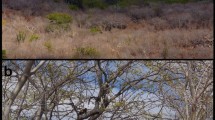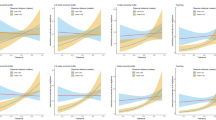Abstract
Encounters between groups of wild chacma baboons (Papio ursinus) can be viewed as a natural experiment to investigate the nature of these primates’ mental representations of large-scale space. During a 16-month field study in a high population density habitat we recorded the foraging routes and the most important resources of a group of 25 individuals. Also, we estimated the locations of additional baboon groups relative to the study group. Routes were less linear, travel speed was higher, and inter-resource distances were larger when other groups were present within 500 m of the focal group; thus, the study group avoided others by taking detours. We predicted that evasive manoeuvres would be characteristic of different possible orientation mechanisms, and compared them with our observations. We analysed 34 evasive manoeuvres in detail. In an area that lacked prominent landmarks, detours were small; larger detours occurred when resources were directly visible, or in the vicinity of a hill offering conspicuous landmarks. In areas without prominent landmarks, detours were along familiar routes and waiting bouts of up to 60 min occurred; on one occasion the study group aborted their entire day’s journey. We discuss these findings in the light of time and energy costs and suggest that the baboons lack the ability to compute Euclidean relations among locations, but use network maps to find their way to out-of-sight locations.





Similar content being viewed by others
References
Altmann SA, Altmann J (1970) Baboon ecology. African field research. University of Chicago Press, Chicago
Batschelet E (1965) Statistical methods for the analysis of problems in animal orientation and certain biological rhythms. American Institute of Biological Sciences, Washington
Benhamou S (1996) No evidence for cognitive mapping in rats. Anim Behav 52:201–212
Boesch C, Boesch H (1984) Mental map in wild chimpanzees: an analysis of hammer transports for nut cracking. Primates 25:160–170
Byrne RW (1978) Plans and errors in memory for urban geography. In: Gruneberg M, Morris P, Sykes R (eds) Practical aspects of memory. Academic, London, pp 93–100
Byrne RW (1979) Memory for urban geography. Quart J Exp Psychol 31:147–154
Byrne RW (2000) How monkeys find their way. Leadership, coordination, and cognitive maps of African baboons. In: Boinski S, Garber P (eds) On the move. How and why animals travel in groups. University of Chicago Press, Chicago, pp 491–518
Cunningham E, Janson C (2007a) A socioecological perspective on primate cognition, past and present. Anim Cogn. doi:10.1007/s10071-007-0078-3
Cunningham E, Janson C (2007b) Integrating information about location and value of resources by white-faced saki monkeys (Pithecia pithecia). Anim Cogn. doi:10.1007/s10071-007-0077-4
Di Fiore A, Suarez SA (2007) Route-based travel and shared routes in sympatric spider and woolly monkeys: cognitive and evolutionary implications. Anim Cogn. doi:10.1007/s10071-006-0067-y
Dyer F (1991) Bees acquire route-based memories but not cognitive maps in a familiar landscape. Anim Behav 41:239–246
Garber PA (1988) Foraging decisions during nectar feeding by tamarin monkeys (Saguinus mystax and Saguinus fuscicollis, Callitrichidae, Primates) in Amazonian Peru. Biotropica 20:100–106
Garber PA (1989) Role of spatial memory in primate foraging patterns: Saguinus mystax and Saguinus fuscicollis. Am J Primatol 19:203–216
Garber PA (2000) Evidence for the use of spatial, temporal and social information by primate foragers. In: Boinski S, Garber P (eds) On the move. How and why animals travel in groups. University of Chicago Press, Chicago, pp 491–518
Garber PA, Hannon B (1993) Modelling monkeys: a comparison of computer-generated and naturally occurring foraging patterns in two species of neotropical primates. Int J Primatol 14:827–852
Gould JL (1986) The locale map of honey bees: do insects have cognitive maps? Science 232:861–863
Healy S, Hodgson Z, Braithwaite V (2003) Do animals use maps? In: Jeffrey KJ (ed) The neurobiology of spatial behaviour. Oxford University Press, Oxford, pp 104–118
Henzi SP, Lycett JE, Weingrill T (1998) Mate guarding and risk assessment by male mountain baboons during inter-troop encounters. Anim Behav 55:1421–1428
Janson C (1998) Experimental evidence for spatial memory in foraging wild capuchin monkeys, Cebus apella. Anim Behav 55:1229–1243
Janson C (2007) Experimental evidence for route integration and strategic planning in wild capuchin monkeys. Anim Cogn. doi:10.1007/s10071-007-0079-2
Kitchen DM, Cheney DL, Seyfarth RM (2004) Factors mediating inter-group encounters in savannah baboons (Papio cynocephalus ursinus). Behaviour 141:197–218
Low B, Rebelo T (1996) Vegetation of South Africa, Lesotho and Swaziland. Department of Environmental Affairs and Tourism, Pretoria
Menzel CR, Savage-Rumbaugh ES, Menzel EW (2002) Bonobo (Pan paniscus) spatial memory and communication in a 20-hectare forest. Int J Primatol 23:601–619
Menzel R, Geiger K, Joerges J, Muller U, Chittke L (1998) Bees travel novel homeward routes by integrating separately acquired vector memories. Anim Behav 55:139–152
Newcombe NS, Huttenlocher J (2000) Making space. The development of spatial representation and reasoning. MIT Press, Cambridge
Noser R (2004) Ecology, route choice and cognitive maps in wild chacma baboons (Papio ursinus). PhD dissertation, University of St Andrews
Noser R, Byrne RW (2006) Travel routes and planning of visits to out-of-sight resources in wild chacma baboons, Papio ursinus. Anim Behav. doi:10.1016/j.anbehav.2006.04.012
O’Keefe J, Nadel L (1978) The hippocampus as a cognitive map. Clarendon, Oxford
Poucet B (1993) Spatial cognitive maps in animals: new hypotheses on their structure and neural mechanisms. Psychol Rev 100:163–182
Shettleworth SJ (1998) Cognition, evolution, and behavior. Oxford University Press, New York
Sigg H, Stolba A (1981) Home range and daily march in a hamadryas baboon troop. Folia Primatol 36:40–75
Stahel W (2002) Statistische Datenanalyse: eine Einführung für Naturwissenschaftler. Vieweg, Braunschweig
Tolman E (1948) Cognitive maps in rats and men. Psychol Rev 55:189–208
Wehner R, Menzel R (1990) Do insects have cognitive maps? Annu Rev Neurosci 13:403–414
Wang RF, Spelke E (2003) Comparative approaches to humans navigation. In: Jeffrey KJ (eds) The neurobiology of spatial behaviour. Oxford University Press, Oxford, pp 119–143
Acknowledgments
We thank the Parks Board of the Limpopo Province, South Africa, for permission to conduct this study at Blouberg Nature Reserve, J. and P. Snyman for logistic support in the field, and C. Janson and E. Cunningham for inviting us to the symposium of the XX. IPS conference on socio-ecological cognition. This study was supported by grants from Zürcher Hochschulverein, Schweizerische Akademie für Naturwissenschaften, Steo-Stiftung, Goethe-Stiftung, Stiftung Thyll-Dürr, Familien Vontobel-Stiftung, Stiftung Annemarie Schindler, Switzerland, and Russell Trust, Scotland, to R.N.
Author information
Authors and Affiliations
Corresponding author
Additional information
This contribution is part of the Special Issue “A Socioecological Perspective on Primate Cognition” (Cunningham and Janson 2007a).
Rights and permissions
About this article
Cite this article
Noser, R., Byrne, R.W. Mental maps in chacma baboons (Papio ursinus): using inter-group encounters as a natural experiment. Anim Cogn 10, 331–340 (2007). https://doi.org/10.1007/s10071-006-0068-x
Received:
Revised:
Accepted:
Published:
Issue Date:
DOI: https://doi.org/10.1007/s10071-006-0068-x




